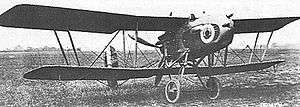Vickers Vampire
| F.B.26 Vampire | |
|---|---|
 | |
| Role | Fighter |
| National origin | United Kingdom |
| Manufacturer | Vickers |
| First flight | May 1917 [1] |
| Status | Prototype |
| Number built | 4 |
| Developed from | Vickers F.B.12 |

The Vickers F.B.26 Vampire was a British single-seat pusher biplane fighter built by Vickers during the First World War.
Four were built by Vickers at Bexleyheath, one of these was subsequently modified to become the F.B.26A.
Design and development
The design was a development of the earlier Vickers F.B.12 prototypes;[2] and was a two-bay biplane with a high-mounted nacelle for the pilot and an initial armament of two .303 in (7.7 mm) Lewis Guns. Behind this was a water-cooled 200 hp (150 kW) Hispano-Suiza engine driving the propeller. The tailplane was mounted on four booms with a single fin and rudder. After modifications to the radiator layout and wing structure and re-armed with three Lewis guns in an Eeman mounting capable of firing up at a 45° angle in order to be able to engage enemy bombers from below, being numbered B1484, the FB.26 was passed to the Aeroplane and Armament Experimental Establishment at Martlesham Heath for evaluation.
The prototype was destroyed on 25 August 1917 when Harold Barnwell, the Vickers test pilot failed to recover from a spin.[3]
A second aircraft, B1486, was built and was operated first by No. 39 Squadron at Woodford and then passed to No. 141 Squadron of the Royal Flying Corps in February 1918. Service evaluation was unfavorable: although performance was satisfactory, its handling qualities were poor.[3]
A third aircraft, B1485, powered by a 230 hp (170 kW) Bentley rotary engine and modified for a ground-attack role, was built in 1918, but by the time it was built the Sopwith Salamander had already been ordered for production and development was abandoned. Three further aircraft had been ordered and allocated service numbers, but it is not known whether any of these were built.[3]
Operators
Specifications (F.B.26 Vampire I)
Data from Vickers Aircraft since 1908 [4]
General characteristics
- Crew: one
- Length: 23 ft 5 in (7.14 m)
- Wingspan: 31 ft 6 in (9.60 m)
- Height: 9 ft 5 in (2.87 m)
- Wing area: 267 ft² (24.8 m²)
- Empty weight: 1,467 lb (667 kg)
- Loaded weight: 2,030 lb (923 kg)
- Powerplant: 1 × Hispano-Suiza 8 water-cooled V-8, 200 hp (149 kW)
Performance
- Maximum speed: 105 kn (121 mph, 195 km/h) at 5,000 ft (1,500 m)
- Service ceiling: 20,500 ft (6,250 m)
- Wing loading: 7.60 lb/ft² (37.2 kg/m²)
- Power/mass: 0.099 hp/lb (0.16 kW/kg)
- Endurance: 3 hours
- Climb to 10,000 ft (3,050 m): 10 min
Armament
- Guns: 2 × 0.303 in (7.7 mm) Lewis Guns
References
Notes
Bibliography
- Andrews, C.F and Morgan, E.B. Vickers Aircraft since 1908. London:Putnam, Second edition 1988. ISBN 0-85177-815-1.
- Bruce, J.M. War Planes of the First World War: Volume Three Fighters. London:Macdonald, 1969. ISBN 0 356 01490 8.
- Green, William and Swanborough, Gordon. The Complete Book of Fighters. New York: Smithmark, 1994. ISBN 0-8317-3939-8.
- Lamberton, W.M. Fighter Aircraft of the 1914–1918 War. Herts, UK:Harleyford Publications, 1960.
- Mason, F.K. The British Fighter Since 1912 London, Putnam, 1992 ISBN 0-85177-852-6
- Flight p764 12 June 1919
External links
| Wikimedia Commons has media related to Vickers Vampire. |